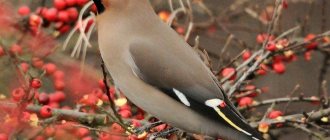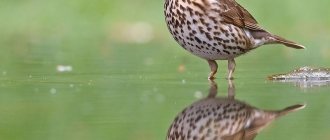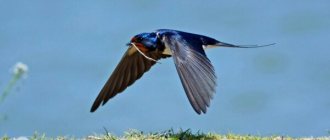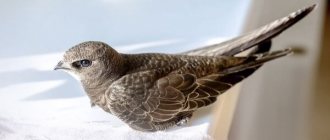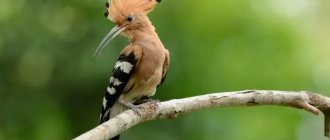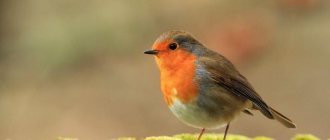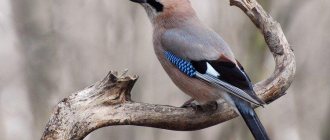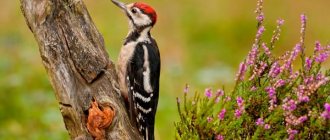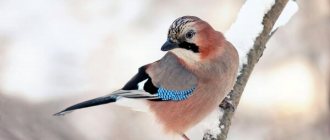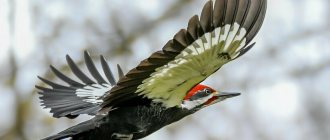- Wild animals
- >>
- Birds
The hummingbird is a miniature bird, flashing its plumage like a scattering of sapphires.
She impresses with her aerial acrobatics, flying quickly, then instantly stopping, soaring and flying up, down or backwards and even upside down, gracefully controlling all stages of flight. They beat their wings extremely quickly (about 80 times per second), resulting in a buzzing sound. The babies fascinated the first Europeans to arrive in North America. Many naturalists of the time wondered whether hummingbirds were a cross between a bird and an insect.
Description of the bird
Photo of hummingbirds in flight
Hummingbirds are the smallest birds living on the planet. They resemble butterflies or moths in size. The smallest hummingbird weighs 2 grams. The average weight of most species is 15-20 grams. The length of an adult bird (from the tip of the beak to the tip of the tail) varies between 7-20 centimeters. In this case, the length of the beak is equal to 1/3 of the total length.
Tail singing
Calyptus Anna's Hummingbird
The male Calyptus Anna's hummingbird makes a loud, high-pitched sound during flight that lasts about 0.05 seconds. Until recently, it was not known how this bird calls. Now, American ornithologists have established that this sound occurs due to vibration in the air flow of the outer lateral tail feathers in the tail of Anna's calyptus.
Appearance
— Advertising —
Hummingbird on a tree
Hummingbirds are gifted with a long, thin beak, with which the bird can easily obtain flower nectar and pollen without landing on the plant. The beak contains the same long tongue, forked at the end. When foraging for food, the tongue protrudes from the beak, curls into a rope and sucks flower nectar into the oral cavity. The bird's beak is used as a weapon to attack the enemy - with its needle-sharp “nose,” the hummingbird pokes out the eyes of birds of prey or pierces the body of insects right through.
Birds are endowed with narrow, long, pointed wings. In flight, the wings bend strongly, which allows the hummingbird to deftly maneuver among the dense thicket. The tail is short; in different species of hummingbirds it can be rounded or sharp at the end, but it always consists of ten feathers spread out to the sides.
Hummingbird flies
— Advertising —
Hummingbirds have short, thin, poorly developed legs. They are unsuitable for walking on the ground, so birds are always in a state of flight. With the help of their powerful wings, which “work” like a propeller, birds are able to hover in the air for a long time.
The colorful plumage that shimmers in the sun is a memorable feature of the hummingbird. The color scheme contains emerald, heavenly, scarlet, and cream tones. Some members of the family have a bright crest or collar. The abdomen is colored light gray or white. The back and head are dark green. The wings and tail are darker than the back. The outer tail feathers are black. The throat (collar) is green with yellow and red splashes. The beak and eyes are black.
Hummingbird sitting on a branch
Under the sun's rays, the bird shimmers with all the colors of the rainbow. The scaly arrangement of the feathers distorts the color of the feathers, their radiance resembles the shine of precious metals.
The feet of some species of hummingbirds are feathered to the tips of the claws. The feathers on the limbs are slightly fluffy, usually white.
Sexual dimorphism is manifested in the richness of feather color. Males look much richer compared to the dull feathers of the fairer sex.
In the photo there is a hummingbird sitting on a tree branch
Hummingbirds moult once a year. It occurs at the end of the breeding season; in migratory birds it lasts 4-5 months, in sedentary birds – up to 3 months. First, the primary feathers on the wings and tail change, then the throat, cheeks and head moult.
How many flaps does a hummingbird make?
A hummingbird flaps its wings.
In flight, a hummingbird's wings bend to form a figure eight. While in motion, they quickly turn first one side or the other. The speed of the wing beats is so fast that the observer sees only a barely noticeable halo surrounding the bird and hears a buzzing sound. In one second, a hummingbird manages to flap its thin transparent wings 10 to 100 times. The smaller the bird, the faster it flaps its wings. Large hummingbirds make 8-10 beats per second, while small hummingbirds make up to hundreds of beats in an instant. During the mating season, the number of flapping increases several times. On average, hummingbirds are able to flap their wings 150-200 times per second.
Hummingbird flies to a flower
Hummingbirds spend most of their time in the air, landing on roosts mainly at night. The movements of hummingbirds are not similar to the movements of other birds. Their flight resembles jumping in the air. They either rush perpendicularly upward, then fall sharply down, or describe a circle. Thanks to the high speed of wing beats, hummingbirds can stop in the air.
Hummingbird Heart
A hummingbird sits on a wire.
The hummingbird has a developed heart muscle. The heart takes up 40% of the body's volume, while the stomach makes up only 5% of the volume. 2.5% of body weight is in the heart. The large size of the heart allows the bird to be in an active state 20 hours a day. During physical activity, the bird's heart makes up to 1.5 thousand beats per minute. The heart rate slows down during night sleep. At rest, the heart makes 500 beats per minute.
Features of character and lifestyle
Photo: Hummingbird Red Book
Hummingbirds fly in any direction and hover steadily in place. Few other birds can do something like this. These birds never stop beating their wings, and their tiny size makes them look like large bumblebees.
They fly mostly in a straight line unless the male performs a male display flight. Males can fly in a wide arc—about 180°, which looks like a semicircle—swinging back and forth as if suspended from the end of a long wire. Their wings hum loudly at the bottom of the arc.
Curious! Hummingbirds contain special cells in their feathers that act like prisms when exposed to sunlight. The light is split into long waves, creating iridescent colors. Some hummingbirds use these bright colors as a territorial warning.
Hummingbirds have the highest metabolism of any non-insect animal. The increased metabolism allows for rapid wing movement and an extremely high heart rate. During flight, their oxygen consumption per gram of muscle tissue is about 10 times higher than that of elite athletes.
Hummingbirds can dramatically reduce their metabolic rate at night or if they are having trouble finding food. They put themselves into a state of deep sleep. They have a fairly long lifespan. Although many die within the first year of life, those who survive can live up to ten years and sometimes more.
What does a hummingbird eat?
Hummingbirds drink nectar
Hummingbirds feed on nectar from the flowers of perennial grasses and shrubs. They also drink tree sap, which contains small invertebrate insects. The hummingbird's diet includes pollen, a supplier of essential amino acids. Arthropods supply protein. Protein food makes up 1/10 of the diet.
Hummingbirds are the most voracious birds on the planet. On a day they eat twice as much food as the birds themselves weigh. This amount of feed is necessary to maintain increased metabolism and maintain body temperature in a static state.
Hummingbird flies to a flower
To meet their needs, hummingbirds are forced to feed every 20 minutes. They fly around up to 2 thousand flowers a day. Bird feeding occurs in the air. A hummingbird, flying up to a flower, launches its long tongue, forked at the end, into the very center and sucks a sweet liquid into its mouth. The nectar enters the esophagus and then directly into the intestines, bypassing the stomach. The stomach digests only insects that the hummingbird catches in flight. The main food of animal origin is wasps, two-winged insects, spiders, ants and small bugs.
Hummingbird soars through the air to eat
Each bird has its own territory for food. The division of feeding grounds allows hundreds of thousands of birds to live comfortably within the same habitat. Birds live alone and do not allow competitors into their territory. They defend their “small homeland” fiercely, rushing at the border violator and starting a fight. Males do not even allow females who have recently been fertilized into their territory. To scare away a competitor from its territory, the bird first consumes food along the periphery of its feeding grounds.
general characteristics
Recommended by topic Blackbirds Woodpecker Heron
Over the past few million years, hummingbirds have been undergoing an evolutionary process that has seen small birds move from one continent to another and back again, shaping their unique traits. Thus, the characteristic features of representatives of this species are the presence of a long beak, bright plumage and a remarkable buzzing sound. A significant number of individuals have multi-colored plumage, but sometimes monochromatic brown hummingbirds or completely white albinos are also found. The colors change depending on the reflection of light, resulting in a characteristic metallic sheen on the feathers.
Hummingbirds are considered one of the smallest birds. Its size varies in the region of 5-22 cm. The bee hummingbird is considered the tiniest among its fellows. The bird has pronounced sexual dimorphism: males are brighter and more colorful than females, but the latter are more impressive in size. The body weight of birds can vary from 2.5 to 20 g.
All members of the family have similar features in appearance, making hummingbirds quite easy to recognize.
They are characterized by the presence of a short body along with elongated wings and a narrow beak.
The needle-like beak is a characteristic feature of the anatomical structure of hummingbirds. It is elongated and at the same time quite thin relative to the size of the bird. The beak is used as a tube, which is used to obtain nectar from flowers using the tongue. Hummingbirds are characterized by having a long forked tongue, with which the bird can feed on nectar.
Hummingbirds have rather long and narrow wings, which are capable of shrinking to increase the maneuverability of their movements in the air. The wings have unusual properties due to the fact that their joints are located quite close to the body. As a result, birds are able to bend and turn in the air. Thanks to this, hummingbirds are considered quite maneuverable birds that can easily combine high-speed flight with rapid braking.
Birds have rather small and short legs. There are four fingers on them, with one of them looking back. Thanks to this, hummingbirds are able to grab onto a branch and sit in this position. On the ground they move exclusively in short lateral jumps, preferring flight.
Representatives of different species of the family are often characterized by the presence of rich colors and bright patterns. For example, males can be recognized by the presence of a brightly colored throat that resembles a collar. In females, the coloring is simpler, but some ladies can combine rainbow colors on their plumage.
The number of heartbeats in birds can accelerate from 250 to 1200 beats in one minute. At night, when hummingbirds rest, this figure drops to 50-180 beats.
In hummingbirds, the volume of the heart is twice the volume of the stomach. The heart occupies half of the body cavity.
Thus, in terms of anatomical features, hummingbirds resemble passerines due to their short neck, long wings and medium-sized head. However, in other respects, birds are distinguished by the presence of unique characteristics, since representatives of each species can boast of having different beaks and colors, which is not typical of passerines.
Poll: Have you ever seen a hummingbird fly in the wild?
Yes, I saw it in person
50%
No, I've never seen it
50%
Voted: 2
Spreading
Area
Hummingbirds in flight
Hummingbirds live in the Western Hemisphere, inhabiting North and South America. Most of the population is concentrated in the Amazon valleys and along the Andes. These heat-loving birds are comfortable in tropical and subtropical climates. Most species of hummingbirds lead a sedentary lifestyle. There are species that live in temperate latitudes. In winter, they migrate to warmer regions, making flights of 1.5 thousand kilometers.
Orange hummingbird flying in the air
There is an opinion that hummingbirds do not live in a climate similar to Russia. However, there is a species of birds that like the subarctic climate zone of Russia. This is a buffy hummingbird that has taken a fancy to the Ratmanov Islands. Birds of this species, according to some sources, appear with enviable regularity in Chukotka and Wrangel Island. “Russian” hummingbirds winter in North America.
Habitats
Hummingbird bird in a nest
Birds nest in dense tropical forests, in highlands, on plains and even deserts. Some species occupy large territories, while some species inhabit a small area - the top of a mountain or the undergrowth. More often, birds settle on the border from mountain to foothill forests at an altitude of 2500 meters. In one area, from two to 20 species of hummingbirds coexist. During the migration season, species diversity in some regions increases to 50 species.
Lifestyle
Beautiful bird hummingbird
Hummingbirds are active birds with a quarrelsome character. Birds are hypermobile during daylight hours. During the day they are constantly in search of food, making endless flights from flower to flower. The body temperature reaches 42 degrees. At night, birds fall into torpor - a motionless state in which the body cools down to 32 degrees and the pulse slows down sharply. Torpor is a vital factor in the life of a hummingbird. Due to lack of food at night, the hummingbird may die. Therefore, to save energy, the bird hibernates until dawn. Inaction preserves the strength to hold out until the first rays of the sun and again rush in search of food.
Despite their miniature size, hummingbirds are fearless birds. If a bird or its family is in danger, it shows extraordinary determination and courage. The hummingbird is not afraid of snakes, falcons, or spiders.
Hummingbird on a man's hand
These tiny birds are not even afraid of humans. They often make homes near people. They can be fed by regularly placing sweet water in a visible place. Getting used to such hospitality, hummingbirds behave like pets.
Hummingbirds have difficulty communicating with their own kind. These birds are selfish by nature. They prefer to live alone, gathering from the flock only in case of forced migration or hunting snakes and birds.
Reproduction
In the photo, a female and a male hummingbird are sitting on a branch.
Hummingbirds are polygamous birds. They form pairs only to fertilize the eggs. Birds living in the southern regions breed year-round; in northern species, the mating season occurs in the summer months. During the breeding season, males engage in fierce battles for territory and the female they like. They sing 70% of the time, often in chorus to keep the song flowing continuously. Some species of hummingbirds stage demonstration performances during the song period - they flap their wings and tail in time with the song. As the female approaches, the male begins to sing even faster. The female, having chosen a partner, sits next to him, which encourages him to mate. Immediately after the act, the male leaves her in search of a new “wife”.
Hummingbird sitting near a flower
Males do not participate in incubation and raising of offspring. The female takes on all responsibilities. She builds a nest, incubates the eggs, and then feeds the newborn babies. Hummingbirds build tiny cup-shaped nests from moss, lichens and spider webs. The bottom and inner sides of the walls are covered with feathers and hairs. The female hummingbird makes its nest on thin tree branches or rocky depressions. The dwelling is attached to the surface using bird saliva. It takes up to 10 days to build a home.
According to the observations of ornithologists, hummingbird chicks growing in closed nests begin to make their first sounds already at a week of age. However, their incessant squeaking attracts the attention of predators. Therefore, females are forced to build open nests - the chicks behave quietly in the sun.
Female hummingbird with chicks
The female has to resort to various tricks so that predators do not notice the nest. For example, when approaching or moving away from a nest, a hummingbird makes zigzag maneuvers, reminiscent of the fall of a leaf. Even the speed of the bird matches the speed of the falling leaf. Flying out of the nest, the female hummingbird imitates the flight of a moth, thereby attracting attention to herself, and not to the nest.
Eggs
Hummingbird eggs in a nest
The female lays two tiny white eggs at a time. The size of the bee hummingbird eggs is 11*8 millimeters, while that of the gigantic hummingbird is 20*12 millimeters. The average weight of eggs is 0.7 grams. Most species of hummingbirds lay one clutch per year. There are species whose females lay eggs 2-3 times a year. Usually those females whose first offspring died in the early stages of development lay eggs again.
The photo compares the key and the size of hummingbird eggs
Hummingbirds lay eggs early in the morning. First one egg appears, and two days later the second one appears. The female incubates the offspring. She spends 90% of her time in the nest. At this time, females behave aggressively towards uninvited guests. Protecting their offspring, they mercilessly plunge their sharp beak into an approaching spider or snake. In order not to die of hunger, the female hummingbird lowers her body temperature from 41 to 32 degrees - this way she saves up to 50% of energy.
Hummingbird nest with eggs
The incubation period lasts three weeks. After 21 days, chicks hatch, measuring 5-7 millimeters in size.
Chicks
Photo of a hummingbird chick
Tiny chicks emerge blind, with short, sparse light down on the back. The short beak quickly lengthens. For the first week, the chicks do not make any sounds and practically do not move. The mother, bringing food, touches each chick - this is how she notifies the cubs about the start of feeding. The female regurgitates food by inserting her beak into the mouth of the chicks. Diet of young animals: nectar and tiny arthropods. Feeding of the chicks occurs twice an hour during the daytime.
Chicks are waiting for their mother
By the 10th day of life, the chicks' eyes open and their wings, tail and back feather. The vocal cords are not yet developed, the body is in a curled state, but the chicks are already beginning to rise. The female warms the chicks for the first two weeks, then the babies begin to independently control heat exchange. By the 14th day of life, the chicks reach 80% of their adult weight. From the 15th day, the chicks sit on the edge of the nest. They become active, look around, and clean their plumage. The female feeds the chicks for about another month. At the age of 25-30 days, the chicks begin to fly and leave the family nest. For another 3-4 weeks, the young live next to their mother, who teaches them how to search for food. The plumage of chicks is not as bright as that of adult birds. The variegated color and silvery tint characteristic of hummingbirds appears towards the end of the first year of life.
Kinds
The hummingbird family consists of more than 300 species living on various continents. Birds are most represented in Ecuador, Venezuela and Colombia. Among the most notable individuals are the following.
Gigantic hummingbird
This is one of the largest representatives of the family, for which it received its characteristic name. Its body weight is about 20-22 g with a body length of 15 cm. The birds live in the western part of Latin America in the foothills. In the summer, they fly higher into mountain forests, which are located at a level of 4.5 thousand m. With the onset of winter, hummingbirds begin to descend closer to the lowlands.
The color of gigantic hummingbirds is green and brown. The back and head are green, the chest and abdomen are brown with yellow spots.
hummingbird bee
This, on the contrary, is the tiniest representative of the hummingbird. Its dimensions are about 6 cm with a weight of no more than 2 g. Males are inferior to females in size. Small birds live in Cuba and are located near nearby islands.
Males have gray-green plumage, which becomes more noticeable and bright during mating games. So, at this time, emerald shades appear brighter on the back, the collar turns red, and the feathers on the sides acquire rainbow colors. Outside this period, the color of males is similar to the appearance of females - it is a light gray shade, in which black and brown colors are observed.
Ruby hummingbird
These are quite small birds, whose body weight is about 4-5 g with a body length of 9 cm. Representatives of this species live in South America, Brazil, Colombia, etc. They live mainly in areas of forests and savannas. Birds of different sexes have different colors. So, males have green plumage, females have a white-brown tint. Females are also distinguished by the presence of a red nape with red feathers.
Swordbeak Hummingbird
These are quite large hummingbirds, which have an average size of about 12-15 g. The length of the bird’s body is about 20 cm. Of this, about 11 cm is occupied by the beak, which is formed as a sharp and rather thin one. At the same time, it has a slight bend at the top.
Males have dark green plumage that shimmers in the sun. The head is red, the throat is gray, as are the belly and chest areas. Females have lighter plumage on top. Juveniles are closer in appearance to females. These hummingbirds live in the Andes. They choose to live in high mountain forests with high humidity.
Common hummingbird
Representatives of this species are characterized by the need to live close to humans.
Representatives of this species are characterized by their small size, making them one of the smallest in the family. The body weight of common hummingbirds ranges from 2-6 g with a body length of up to 9 cm. Such birds have rather short wings, but at the same time a long tail. Their back is blue-green and their belly area is grey. Males have a bright red collar.
Birds live in southern Canada, as well as in the northern United States. In winter, they prefer to migrate to Mexico and Cuba.
Kalypta Anna
This is a small bird, whose body weight is about 4.5 g with a length of 9-10 cm. Females differ from males in color. Thus, females have red stripes on their throats, while males have red stripes on their head and neck. Juveniles do not have red pigment. The western part of North America is becoming a characteristic area of residence for these hummingbirds. To do this, they choose dense bushes and thickets. In addition, these birds are able to settle near human buildings and city parks.
Plasma Topaz Hummingbird
The diet of representatives of this species consists mainly of insects.
They rarely consume nectar. These are quite large birds that weigh about 9-10 g with a body length of 14 cm. Their head is black, the chest area is green with blue patches present, and there is also a black stripe on the border. There is a scarlet scruff, and there are orange feathers on the tail. The abdominal area is golden in color.
Chestnut-breasted hummingbird
These are medium-sized hummingbirds, which, with a body weight of 9 g, reach a size of 12 cm. They have a rather short and thick beak, which distinguishes them from their relatives. The plumage is green on top, the head is lemon-colored. The bottom of the hummingbird is painted in a brick shade. Females are characterized by having pale yellow droplets on their necks. Representatives of this species live in the dense tropics of Peru and Venezuela.
Buffy Hummingbird
This is the only representative of the hummingbird family that lives in Russia. Its body weight is about 4 g with a length of 8 cm. The buffy hummingbird is characterized by the presence of a wide tail, short and narrow wings. Its color resembles that of a sparrow. The body has a brown tint. There is a red spot on the throat. Females have green upperparts and white underparts. Hummingbirds live in Alaska, in the western part of Mexico, where they spend the winter. Those birds that live in Russia move to Central America for a while.
Sparkling Hummingbird
Lifespan
Photo of a hummingbird bird
A high mortality rate is observed in hummingbirds at an early age. Only 40% of the chicks survive. High mortality is associated with unfavorable weather conditions (in the first two weeks, the cubs still cannot control their body temperature and freeze), and attacks by birds of prey (falcons, crows, bats).
Hummingbird on a twig
In the wild, hummingbirds live on average 5-8 years. There is a known case when a hummingbird lived for 12 years. The record belongs to an individual blue-throated hummingbird. Captive birds can live 3-4 years.
Enemies of hummingbirds
The hummingbird's enemy is the tarantula.
Tiny birds are happily eaten by tarantulas and tree snakes. Predators sneak up to hummingbird nests and swallow the female and her eggs whole.
When an enemy approaches, the hummingbird gives warning signals to other birds, consisting of a series of short, high-frequency sounds. Having gathered in a small flock, hummingbirds attack ravens and hawks. They furiously rush to attack, pecking out the enemy's eyes.
Another enemy of the hummingbird is the bat.
Birds of prey from the corvid and toucan families are not averse to feasting on small birds. Bats rob nests, and forest falcons and pygmy owls hunt mainly for adult hummingbirds.
People are involved in the decline in the number of hummingbirds by destroying miniature birds for the sake of colorful feathers sparkling in the sun.
Reproduction
The hummingbird's nest, where they lay their eggs, is as small as its owner's, about the size of a small cup. These hummingbirds create nests from cobwebs, fluff, blades of grass, and pieces of bark.
Typically, hummingbirds lay 2 eggs per clutch, each 10 mm in diameter. The female hummingbird incubates the eggs for 14-19 days, then for several months after the chicks are born, she feeds them until they are ready for independent life.
Voice
The hummingbird sings.
Hummingbirds make short, ringing calls that last half a second. Sometimes they turn into a series of calls. The intonation of the voice changes depending on the situation. If danger is approaching, the bird makes aggressive sound signals.
Vocalization ends with a guttural, sharp sound that is unpleasant to the human ear. Grown-up chicks, like their older brothers, produce low-frequency short trills. The structure of the larynx is the same as that of parrots, suggesting that hummingbirds are capable of learning song.
Hummingbird sings sitting on a branch
Some species of hummingbirds perform drawn-out whistle songs lasting 2-3 seconds. And the songs of dwarf bees last 20-30 seconds. The songs of hummingbirds during the mating season are melodic and loud. Individual sounds can be heard at a distance of 100 meters.
Environmental activities
The metallic or iridescent color of hummingbird feathers and the tiny size of the bird itself made them a target for collectors in the 19th century, with wealthy individuals often displaying a box of stuffed hummingbirds in their home. Fortunately, most species of hummingbirds have adapted to the presence of humans.
It is important to keep hummingbird habitats stocked with native plants to ensure the birds have food available. Gardens that contain flowers suitable for hummingbirds have helped find balance with humans in the habitat. However, in many parts of the world the human population is growing so quickly that hummingbirds are losing their habitat.
Keeping at home
A hummingbird sits on a person's hand.
Tiny birds are kept as pets. Hummingbirds are kept in small cages or ventilated boxes equipped with branch perches, a drinker and a feeder. Hummingbird chicks are fed every 15 minutes.
The smallest hummingbird
The house is installed on the sunny side. At night the birds sleep soundly. If they are touched, they will not even move.
Hummingbirds live shorter lives in captivity than in the wild. The fact is that for a full and healthy life, a bird needs special nectar, which is impossible to reproduce at home. In addition, birds imprisoned in a cage are inactive, and this leads to interruptions in the functioning of the heart and metabolic disorders.
Photo of a hummingbird and a human
Hummingbirds are bred in California. Special conditions close to natural ones have been created for birds. The young live in special cages that maintain the required ambient temperature. There are isolated cases where scientists managed to mate hummingbirds in captivity. The fact is that, deprived of the joys of mating games, birds forget about their reproductive function. The first increase was obtained in a European zoo in Germany in 1977. Over the course of half a century, ornithologists have obtained offspring from 20 species of hummingbirds, which amounted to a third of all species participating in the experiment.
Aces
Hummingbirds fly at incredible speeds
Not a single bird can fly the way hummingbirds fly: on their side, on their back, and with their tail forward. They can easily hover over a flower. Hummingbirds' legs are very weak, so the birds are practically unable to move on the ground. But they fly truly masterfully! Thanks to their small but very strong wings, hummingbirds are able to develop great speed, and therefore can easily overtake larger birds.
Interesting facts about hummingbirds
Hummingbirds fly backwards and forwards
- In Cuba, bee hummingbirds are called "zumzum" and are considered a symbol of love.
- Some species of hummingbirds spend up to 20 hours a day in flight.
- Bee hummingbirds are a favorite delicacy of dragonflies, mantises and frogs.
- The coat of arms of the island nation of Trinidad and Tobago features a hummingbird.
- During migration, hummingbirds are able to cover a distance of 800 kilometers in 20 hours without resting.
- Hummingbirds are the only birds that can fly backwards and forwards (in the opposite direction). True, with such a flight the birds quickly get tired. Moving forward, hummingbirds reach speeds of 80 kilometers per hour.
Video
And in conclusion, an interesting documentary about our today’s heroine - “The Secret Life of a Hummingbird.”
Author: Pavel Chaika, editor-in-chief of Poznavaika magazine
When writing the article, I tried to make it as interesting, useful and high-quality as possible. I would be grateful for any feedback and constructive criticism in the form of comments on the article. You can also write your wish/question/suggestion to my email [email protected] or Facebook, with respect, the author.
Author page
